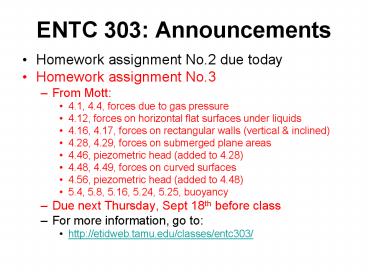ENTC 303: Announcements
1 / 21
Title: ENTC 303: Announcements
1
ENTC 303 Announcements
- Homework assignment No.2 due today
- Homework assignment No.3
- From Mott
- 4.1, 4.4, forces due to gas pressure
- 4.12, forces on horizontal flat surfaces under
liquids - 4.16, 4.17, forces on rectangular walls (vertical
inclined) - 4.28, 4.29, forces on submerged plane areas
- 4.46, piezometric head (added to 4.28)
- 4.48, 4.49, forces on curved surfaces
- 4.56, piezometric head (added to 4.48)
- 5.4, 5.8, 5.16, 5.24, 5.25, buoyancy
- Due next Thursday, Sept 18th before class
- For more information, go to
- http//etidweb.tamu.edu/classes/entc303/
2
Chapter 6 Flow of Fluids
- Example of fluid flow systems
- Fire sprinkler system
- Water distribution system in the house, city etc.
- Cooling systems (refrigerants, brines, chilled
water, etc.) - Fluid Power System
- Hydraulics
- Pneumatics
- Irrigation system in agriculture
3
Definitions
- Volume (Volumetric) Flow Rate
- Q Cross Sectional AreaAverage Velocity of the
fluid - Q Av
- Weight Flow Rate
- W gQ
- Mass Flow Rate
- M rQ
v
Q Volume/Unit time Q AreaDistance/Unit Time
Volume
4
Units and Conversion Factors
- Q m3/sec, ft3/sec
- W N/sec, lb/sec
- M kg/sec, slugs/sec
- Volume Flow Rate
- 1 L/min 0.06 m3/h
- 1 m3/sec 60,000 L/min
- 1 gal/min 3.785 L/min
- 1 ft3/sec 449 gal/min
5
Typical Volume Flow Rates
6
Key Principles in Fluid Flow
- Continuity for any fluid (gas or liquid)
- Mass flow rate In Mass Flow Rate out
- M1 M2
- r1A1v1 r2A2v2
- Continuity for liquids
- Q1 Q2
- A1v1 A2v2
M1
M2
7
Example
- If d1 and d2 are 50 mm and 100 mm, respectively,
and water at 70 C is flowing at 8 m/sec in
section 1, determine v2, Q, W, M.
v1
v2
d2
1
2
d1
8
Pipe and Tubing
- Steel Pipes General Purpose and come in standard
sizes (specific thickness and diameter) - Steel Tubing Fluid power systems, condensers,
heat exchangers. Sizes designated by outside
diameter and thickness. Typical sizes 1/8 2
inches. - Copper Tubing Plumbing, compressed and
refrigeration lines. Types K and L. Type K is
thicker than type L.
9
Pipe and Tubing
- Ductile Iron Pipe Water, gas, sewage.
- Other types PVC, brass, concrete, nylon, etc.
Used in corrosive environments or in special
applications (labs, manufacturing plants, etc.)
10
Recommended Velocity of Flow in Pipe or Tubing
- To minimize internal erosion, Figure 6-2 and
Table in page 164 in Mott - For same flow rate (Q) smaller diameter means
higher velocity and vice versa
For same Flow Rate, Q
Recommended Range of Velocity
11
Example
- Determine the maximum allowable volume flow rate
in L/min that can be carried through a standard
steel tube with an outside diameter of 1-1/4 and
0.065 in wall thickness if the maximum velocity
is to be 3.0 m/sec.
12
Example
- Determine the required size standard Schedule 40
steel pipe to carry 192 m3/hr with a maximum
velocity of 6.0 m/sec.
13
(No Transcript)
14
Conservation of EnergyBernoullis Equation
- Energy cannot be created or destroyed, just
transformed - Three forms of energy in fluid system
- Potential
- Kinetic
- Flow energy
15
Potential Energy
- Due to the elevation of the fluid element
- Where,
- w weight of fluid element
- z elevation with respect to a reference level
16
Kinetic Energy
- Due to the velocity of the fluid element
- Where,
- v average velocity of the fluid element
17
Flow Energy
- Flow work or pressure energy
- Amount of energy necessary to move a fluid
element across a certain section against pressure - Where,
- p pressure on the fluid element
18
Total Energy and Conservation of Energy Principle
- E FE PE KE
- Two points along the same pipe
- E1 E2
- Bernoullis Equation
19
Heads
Assumption No energy is added or lost
Assumption Energy level remains constant
20
(No Transcript)
21
Restrictions on Bernoullis Equation
- Valid only for incompressible fluids
- No energy is added or removed by pumps, brakes,
valves, etc. - No heat transfer from or to liquid
- No energy lost due to friction
- Note No system satisfies this condition, but
- Bernoullis equation can still be used
to - estimate changes in heads values































